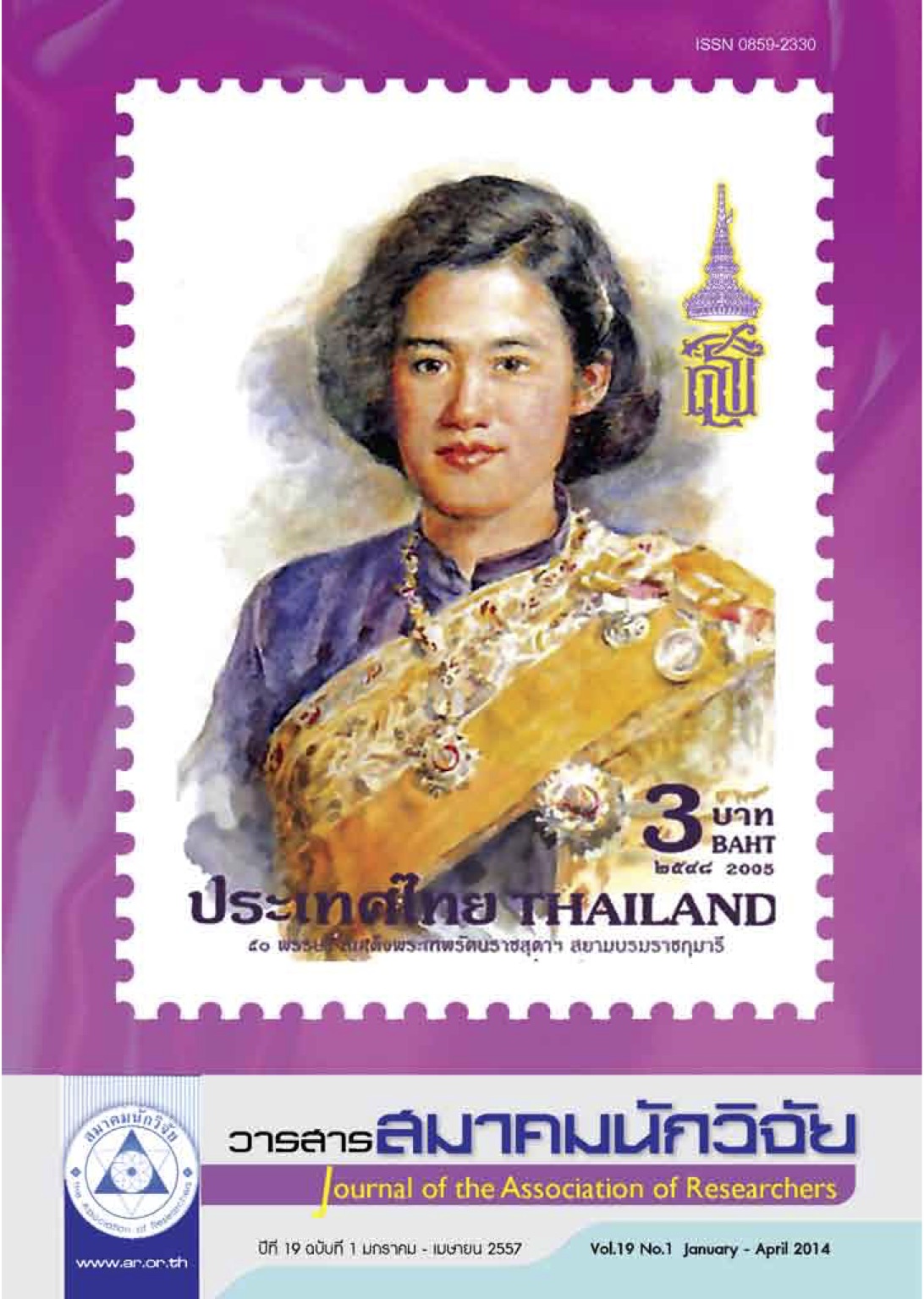AN OPERATIONAL EFFECTIVENESS FOR ENTREPRENEURS’ MANAGEMENT OF CERAMIC INDUSTRIAL HANDICRAFTS PRODUCTS AT LAMPANG PROVINCIAL AREA
Main Article Content
Abstract
The objectives of this study were to evaluate, to analyze confirmatory factor, and to examine the causal relationships with the operational effectiveness for Entrepreneurs’ Management of Ceramic Industrial Handicrafts Products (EMCIHP) at Lampang provincial area. Data from 127 entrepreneures of all 183 ceramic factories were analyzed by statistical pacage for computer program. Research results were as follows: 1) As a whole of all categories of the EMCIHP operational effectiveness, it was at the low level (p< .05). When identifying as a whole of each category, it was found that only one category of product quality was at the high level. On the contrary, the following 4 categories were at low level, namely, knowledge management, organizational network, marketing mix, and operational effectiveness (successfulness); 2) For confirmatory components analysis with the EMCIHP model, it revealed as follows: a) Knowledge management – 4 factors as crucial components and the first priority as “Knowledge building”; b) Organizational network–1 of 3 factors as crucial components and the first priority as “Resources management within industrial factory”; c) Product quality–5 of 6 factors as crucial components and the first priority as “Product design characteristics”; Marketing mix–4 factors as
crucial components and the first priority as “Products”; and d) Oerational effectiveness
(successfulness) –4 factors as crucial components and the first priority as “Financial dimension”; and 3) The structural equation model was confirmed with statistical assumptions as Chi-square = 130.51, df = 181, p-value = 0.997, RMSEA = 0.000, It could be explained in term of causal relationship as follow: The operational effectiveness for the EMCIHP at Lampang provincial area, most of them got the high direct effects from the 4 following crucial factors: Product quality at the high level
(Direct Effect=0.81) and those 4 following factors at the low level, namely Knowledge management (Direct Effect=0.19), Organizational networking (Direct Effect=0.19), and Marketing mix (Direct Effect=0.13). All 4 crucial factors could be predicted the operational effectiveness of the EMCIHP at Lampang provincial area at the 75.10 percent and at the .05 level of significance.”
Article Details
บทความที่ปรากฏในวารสารนี้ เป็นความรับผิดชอบของผู้เขียน ซึ่งสมาคมนักวิจัยไม่จำเป็นต้องเห็นด้วยเสมอไป การนำเสนอผลงานวิจัยและบทความในวารสารนี้ไปเผยแพร่สามารถกระทำได้ โดยระบุแหล่งอ้างอิงจาก "วารสารสมาคมนักวิจัย"
References
ปรีดา พิมพ์ขาวขำ. (2547). เซรามิกส์. พิมพ์ครั้งที่ 5. กรุงเทพมหานคร: จุฬาลงกรณ์มหาวิทยาลัย.
พรชนก ทองลาด. (2549). อิทธิพลของพรหมวิหารธรรมที่มีต่อความพึงพอใจในการทำงานและปฏิบัติงานของพนักงาน โรงงานเซรามิกในภาคเหนือตอนบน. ดุษฎีนิพนธ์สาขาบริหารธุรกิจ มหาวิทยาลัยรามคำแหง.
ยงยุทธ เศรษฐกร. (2547). รายงานการวิจัยความสัมพันธ์ระหว่างความฉลาดทางอารมณ์และความพึงพอใจในการ ทำงานของพนักงานโรงงานเซรามิก จังหวัดลำปาง. ลำปาง: สถาบันราชภัฎลำปาง.
วาสนา สำเภาจันทร์. (2547). กลยุทธ์การตลาดของอุตสาหกรรมอัญมณีและเครื่องประดับ กรณีศึกษาอุตสาหกรรม ประเภทเครื่องประดับเงินสเตอริงในประเทศไทย. วิทยานิพนธ์คณะวารสารศาสตร์และสื่อสารมวลชน มหาวทิยาลยัธรรมศาสตร.์
วิจารณ์ พานิช. (2549). การจัดการความรู้ฉบับนักปฏิบัติ. พิมพ์ครั้งที่ 3. กรุงเทพมหานคร: สุขภาพใจ. ศีจ ศิริไกร. (2555). “ธุรกิจไทยกับการใช้ความรู้บริหารการปฏิบัติการ,” วารสารบริหารธุรกิจ, 35(134), 46-64. ศิริวรรณ เสรีรัตน์. (2543). หลักการตลาด. กรุงเทพมหานคร: ธีระฟิล์มและไซแท็กซ.์
สำนกังานเศรษฐกิจอุตสาหกรรม. (2554). สรุปภาวะเศรษฐกิจอุตสาหกรรมปี 2554 และแนวโน้มปี 2555. ค้นเมื่อ 11 มกราคม 25550, จาก http://www.oie.go.th/academic
สุทธู ศรีไสย์. (2551). สถิติประยุกต์สำหรับงานวิจัยทางสังคมศาสตร์. กรุงเทพมหานคร: จิราภาการพิมพ์.
Beesley, L., & Cooper, C. (2008). “Defining knowledge management (KM) activities: Towards consensus.” Journal of Knowledge Management, 12(3), 48-62. Casson M. & Cox, H. (2008) “An Economic Model of Inter-Firm Networks” in Casson, M. and Giusta, M. (eds.) The Economics of Networks, Edward Elgar, Cheltenham Drucker, P. F. (1994). Innovation and entrepreneurship: Practice and principles. London: Heinemann. Kanungo, R. N. (1999). Entrepreneurship and innovation: Models for development. London: Sage. Kaplan, R.S., & Norton, D. P. (1992). “The balanced scorecard-measures that drive performance.” Harvard Business Review, 83(7-8), 172-180. Kline, R.B. (1998). Principles and practice of structural equation modeling. New York: Guild Press. Kotler, P. (2001). Principle of marketing. New Jersey: Prentice-Hall. Porter, M. E. (1985). “Technology and competitive advantage.” Journal of Business Strategy, 5(3), 60-78. Liu, P.L., Chen, W.C., & Tsai, C. H. (2004). An empirical study on the correlation between knowledge management capability and competitiveness in Taiwan’s industries. Technovation, 24, 971977. Steiger, J. H. (1990). “Structural model evaluation and modification: An interval estimation approach.” Multivariate Behavioral Research, 25(2), 173-180. Ullman, J. B. (2001). Structural equation modeling. In B. G. Tabachnick & L. S. Fidell (Eds.), Using multivariate statistics (4th ed., pp. 653–771). Boston, MA: Allyn & Bacon. Urabe, K., Child, J., & Kagono, T. (1988). “Innovation and management: International comparisons,” In The concept of Fit in Contingency Theory. Berlin: Walter de Gruyter& Co. Zhao, F. (2001). Managing innovation and quality of collaborative R & D. Melbourne: International & 8th National Research Conference.


